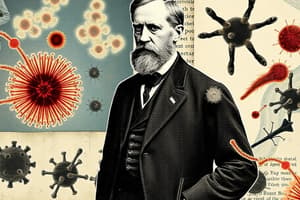Podcast
Questions and Answers
What was Dmitri Ivanovsky studying in 1892?
What was Dmitri Ivanovsky studying in 1892?
- Ebola virus
- Yellow fever
- Tobacco mosaic disease (correct)
- Foot-and-mouth disease
What was the result of Ivanovsky's experiment with the fine filter?
What was the result of Ivanovsky's experiment with the fine filter?
- The filter was too coarse to trap the bacteria
- The liquid lost its power to infect other plants
- The liquid still retained the power to infect other plants (correct)
- The bacteria responsible for the infection was found
What was Martinus Beijerinck's conclusion about the infectious agent?
What was Martinus Beijerinck's conclusion about the infectious agent?
- It was a 'contagious living fluid' (correct)
- It was a type of bacteria
- It was a virus
- It was a simple toxin
What was the term coined by Beijerinck to describe the infectious agent?
What was the term coined by Beijerinck to describe the infectious agent?
What was the discovery made in the 1930s about viruses?
What was the discovery made in the 1930s about viruses?
What is the current understanding of viruses?
What is the current understanding of viruses?
What was the significance of Beijerinck's experiment with the eight-year-old boy?
What was the significance of Beijerinck's experiment with the eight-year-old boy?
What is a challenge to our increasing knowledge of viruses?
What is a challenge to our increasing knowledge of viruses?
What was the main idea that Louis Pasteur supported in the 19th century?
What was the main idea that Louis Pasteur supported in the 19th century?
What was the process that Pasteur disproved?
What was the process that Pasteur disproved?
What was the disease that Pasteur was particularly concerned about?
What was the disease that Pasteur was particularly concerned about?
What was the result of Pasteur's experiment with rabies-infected tissue?
What was the result of Pasteur's experiment with rabies-infected tissue?
What was the significance of Joseph Meister in Pasteur's work?
What was the significance of Joseph Meister in Pasteur's work?
What did Pasteur assume about the germ that caused rabies?
What did Pasteur assume about the germ that caused rabies?
What was the outcome of Pasteur's vaccine administration to Joseph Meister?
What was the outcome of Pasteur's vaccine administration to Joseph Meister?
What diseases would have been familiar to Pasteur, in addition to rabies?
What diseases would have been familiar to Pasteur, in addition to rabies?
Flashcards are hidden until you start studying
Study Notes
Virus History
- Louis Pasteur, a French scientist, was a proponent of the germ theory of disease, which states that illnesses are caused by living microorganisms (microbes) that can spread between people and multiply in the body.
- Pasteur identified and studied bacteria involved in diseases and disproved the idea of "spontaneous generation" of microbes.
- He was unable to find the germ responsible for rabies, although he believed it existed, and later discovered that it was caused by viruses.
- Other viral diseases known during Pasteur's time include the common cold, mumps, measles, and polio.
- Pasteur developed the first vaccine for rabies in 1885, using a weakened extract of tissue infected with rabies, which was successfully tested on a 9-year-old boy named Joseph Meister.
Discovery of Viruses
- In 1892, Russian scientist Dmitri Ivanovsky discovered that tobacco mosaic disease was caused by a filterable agent, which could not be trapped by a fine filter, leading him to believe it was not a bacterium.
- Ivanovsky's findings were later confirmed by Dutch botanist Martinus Beijerinck, who concluded that the infectious agent was not a microbe but a "contagious living fluid".
- Beijerinck coined the term "virus" from the Latin word for poison or pestilence.
- In the 1930s, filters with tiny pores were developed, proving that viruses are particulate in nature, and the first electron microscopes were used to visualize viruses.
Characteristics of Viruses
- Viruses are not living cells like bacteria but rather tiny packets of genetic material.
- They are responsible for various diseases, including rabies, common cold, mumps, measles, polio, foot-and-mouth disease, yellow fever, AIDS, and Ebola virus.
- The discovery of viruses has led to a greater understanding of infectious diseases, but new viral diseases continue to emerge, challenging our knowledge of them.
Studying That Suits You
Use AI to generate personalized quizzes and flashcards to suit your learning preferences.




